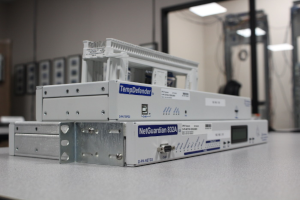Check out our White Paper Series!
A complete library of helpful advice and survival guides for every aspect of system monitoring and control.
1-800-693-0351
Have a specific question? Ask our team of expert engineers and get a specific answer!
Sign up for the next DPS Factory Training!

Whether you're new to our equipment or you've used it for years, DPS factory training is the best way to get more from your monitoring.
Reserve Your Seat TodayThere's never an exactly "typical day" for your field techs. They're installing equipment at mountaintop cell sites, driving between substations, responding to after-hours alerts, and often working from locations with limited or no network access.
Despite this, you still need full situational awareness of your network.
That involves real-time alerts, remote control, and the ability to acknowledge alarms (without needing to boot up a laptop or ask/beg IT for VPN credentials).
Unfortunately, many legacy monitoring systems (even those that claim to be "mobile friendly") don't make good on that promise. Some just shoot out vague text messages. Others still expect your techs to remote into a workstation - or worse, require app installs that run in conflict with security policies.
In 2025, that's not actual "mobile NOC monitoring". It's a liability waiting to cost you.
Let's walk through what often passes as "mobile NOC support" in some older systems:
If you're like many of our clients, this should sound pretty familiar.
This was tolerable in a world where most monitoring happened from desks. But in 2025, when techs are moving around 24/7 and sites are more remote than ever, you can't afford that kind of delay or downtime.
Let's imagine what "good" actually looks like. If you were designing a mobile-first NOC tool from the ground up, it would include:
If your current setup doesn't deliver on all of these points, it's not fully mobile-ready, which is probably holding you back in various ways.
Here's a practical checklist you can use when evaluating any mobile-ready monitoring system:
| Feature | Must-Have? |
|---|---|
| 1. Full mobile access via browser (no app installs) | Yes |
| 2. SMS, voice, and email alerts with full context | Yes |
| 3. Remote alarm acknowledgment with audit trail | Yes |
| 4. Secure relay control from phone/tablet | Yes |
| 5. No required firewall holes or VPNs | Yes |
| 6. Voice alerting & phone-keypad control | Yes |
| 7. Works without LAN/Wi-Fi (cell-only sites) | Yes |
Most vendors will hit 2 or 3 of these. But unless a solution hits every single one, your mobile NOC isn't fully covered.
We've been building mobile-ready monitoring gear long before it was so common - because our clients needed it.
DPS systems have long been deployed in environments where downtime is costly, and physical access is limited or delayed.
That's why every DPS product is designed to be:
The T/Mon LNX is the central nervous system of your monitoring infrastructure. With its mobile-optimized web interface, your phone becomes your handheld NOC command center.
From a secure HTTPS connection, you can:
That means no apps, no installs, and no dependencies. Just open your mobile browser and take action.
Many of our most popular RTUs - including the NetGuardian 216 G6 and NetGuardian 832A G6 - are built to keep sending alarms even when your Ethernet or LAN goes down.
They do this by:
They also monitor critical inputs like:
With DPS NetGuardians, you won't just get alerted - you'll get useful data that helps you fix the problem faster.
Smartphones are great, but what if your tech is using a flip phone? Or standing in a Faraday-caged shelter?
Voice alerting with DTMF control is the ultimate backup plan.
When an alarm occurs:
This isn't optional fluff. It's critical functionality that works even when the newest tech doesn't.
Let's say your site is extremely remote - no LAN, no cell coverage, and no public telephone access. Most vendors would say: "We can't monitor that site."
We say: "Let's set up Order Wire."
With DPS Order Wire and OffNet calling features, you can:
Whether you're operating in the desert, a mountaintop, or underground - you stay connected.
There are a lot of companies selling "monitoring tools" that tick a few boxes on the spec sheet, but ultimately have limitations.
These tools talk mobile but require apps. They talk about "security" but require extensive firewall holes. They talk about "flexibility" but only support LAN as a connectivity method.
At DPS, we build real tools for real sites.
Our advantage comes from 30+ years of deep engineering and close client collaboration. That gives us:
You'll never have to explain to us what a remote RTU does or why your tech needs to acknowledge an alarm from a mountaintop in 30 seconds or less.
We already get it - because we've lived it.
A major DPS client in Wyoming has dozens of sites that operate without any wired internet access. Winter storms frequently knock out LAN for hours or days.
Here's how their DPS system works:
This eliminates delays, dead zones, and guessing.
Mobile NOC tools shouldn't require huge tradeoffs. You (and your customers/users) deserve a solution that's:
At DPS, we make that real every day for telecoms, power utilities, transportation providers, and government agencies.
If you're tired of half-fixes and "band-aid" patches, it's time to upgrade.
If you're evaluating mobile NOC options, let's have a 10-minute conversation. We'll talk through your current challenges, show you how other teams solved them, and get you a written proposal you can review at your own pace.
Call now: 559-454-1600
Email: sales@dpstele.com
You won't get a pushy salesperson. You'll speak with an expert who's done this before - and can help you design a solution that works.
Let's make sure your field techs have the tools they need to keep your network running - no matter where they are.

Andrew Erickson
Andrew Erickson is an Application Engineer at DPS Telecom, a manufacturer of semi-custom remote alarm monitoring systems based in Fresno, California. Andrew brings more than 18 years of experience building site monitoring solutions, developing intuitive user interfaces and documentation, and opt...